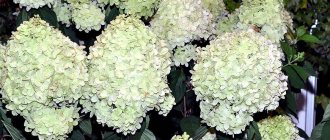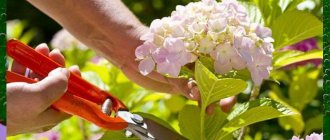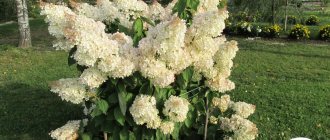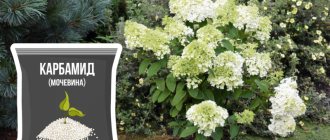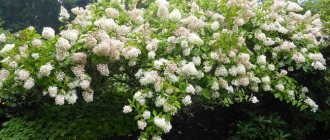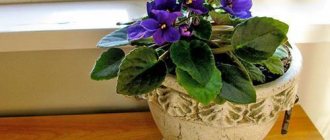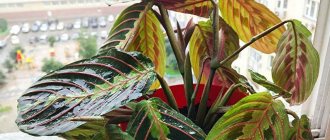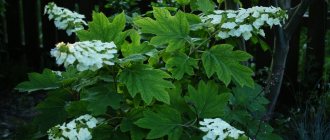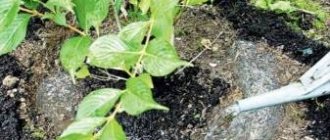Nowadays, there is a huge variety of species and subspecies of this ornamental shrub. Passing by the place where hydrangea grows, you cannot help but stop your gaze on it, because its appearance fascinates and delights. Hydrangea is considered the most common and popular bush to grow among gardeners. And this is not without reason, because the plant is distinguished by long-lasting luxurious flowering, ease of care, and what’s more, the variety of varieties of this shrub that differs not only in hardiness, but also in color, size and shape of inflorescences surprises and delights. Each gardener can choose to grow in his garden the variety that is right for him. If you want this ornamental shrub to become a decoration for your garden, then you must comply with all the conditions for growing and caring for this plant. And we will look at how to do this in this article. But if briefly about the main thing, then this bush must be provided with comprehensive care measures, and first of all it is necessary to choose a favorable place for the growth of this crop. Although many people make the mistake of planting hydrangea in the wrong place, which in turn has a rather negative impact on the overall well-being of the hydrangea. Therefore, take this moment seriously. Well, we’ll tell you further how to plant and care for this plant.
Which Hydrangea paniculata to choose: list of the best varieties with photos and descriptions
The diversity of this species is enormous. On the market you can find a large number of varieties with different bush sizes, hardiness, flower color and other characteristics. There are whole series of varieties of ornamental crops with similar characteristics that can be identified by name - for example, Pink, Magical, Vanille and others.
From this large number of varieties, we will introduce you to the old and new, the largest and dwarf, colorful and most beautiful varieties of flowering shrubs with photos and descriptions.
Pest and disease control
Most hydrangea diseases are caused by improper care and maintenance conditions. These are chlorosis, leaf burns, rotting of the root system, yellowness, leaf fall. In these cases, it is enough to adjust the regime, adjust the watering and fertilizing schedule, and create shade.
Fungal diseases are treated with special drugs - fungicides and antiseptics. To do this, you first need to get rid of damaged areas and excessive moisture. Viral ringspot has no cure, so diseased shrubs will have to be removed before the disease spreads further.
The most dangerous enemy of tree hydrangea is nematodes, which are difficult to control. Don't forget about routine preventative treatment to minimize the risk of damage. Among other parasites and pests, hydrangea is loved by slugs, aphids and spider mites, which can be eliminated mechanically and with insecticides.
Photo: tsvetovodovklub.ru
Low-growing varieties of Hydrangea paniculata
This group of relatively dwarf shrubs is represented by a considerable number of bred varieties. Let us describe the most striking varieties.
Hydrangea paniculata Bobo
First introduced in Belgium, where its compact dimensions won many awards. The height of an adult plant of the Bobo variety reaches no more than 0.9 m.
In mid-summer the bushes are covered with large white flowers. They turn pink as the season progresses.
This is an excellent choice of shrub for a hedge or border plant.
You can learn more about planting and caring for this plant from our article - 'A complete guide to growing Hydrangea paniculata'
Hydrangea paniculata Bombshel
This compact shrub reaches about 80 cm in height and width at maturity. Covered with white flowers against green foliage from early summer until frost, this variety produces more flowers per plant than any other Hydrangea.
Blooms earlier and lasts longer than most other Hydrangea paniculata varieties (July to September).
Hydrangea paniculata Cotton Cream
A relatively new variety, released in 2022. A compact plant with beautiful, small, showy cream-colored flowers. The shrub blooms several times per season.
The height of Cotton Cream is up to 80 cm. It is a winter-hardy crop that can withstand frosts down to -30 °C and below.
Hydrangea Little Lime
A relatively compact plant, it grows on average up to a meter in height and produces large (up to 30 cm in length) panicles.
Tightly adjacent inflorescences are light green in color, which closer to autumn acquire shades of pink and later burgundy. This variety grows quite slowly.
Hydrangea paniculata Sunday Fraise (Sundae Fraise)
This variety was created by French breeders based on another variety - Vanilla Fries. The height of the plant is no more than 1 m.
The shrub forms a ball, which practically does not require the formation of a crown. Like most varieties, Sunday Frize blooms white inflorescences, but turns pink closer to autumn. Flowering season is from June to October.
Varieties of hydrangea
At this point in time, there are around 80 varieties of hydrangea. The main difference of this shrub is its large leaves of a rich green hue and large spherical inflorescences in a variety of colors. In the center there are small fruit flowers, which after a certain amount of time form boxes with seeds. And along the edges of the inflorescences there are quite large flowers that are not capable of producing fruits, and also along the edge there are several enlarged sepals. In general, this flower does not require a lot of attention to itself when caring. There are several varieties of hydrangea, but the most favorite are: large-leaved (or garden), tree-like and paniculate. It is these varieties that are actively in demand among flower growers. Although recently our gardeners have begun to actively breed such rare species of this shrub as oakleaf and petiole. Let's take a closer look at the most famous and common types of hydrangeas below.
High varieties of tree-like Hydrangea paniculata
These varieties are more suitable for medium and large garden and summer cottage plots. The average height of shrubs can reach 2.5 – 3 meters. We will describe the most popular varieties among domestic flower growers.
Hydrangea paniculata Unique
This variety was developed in Belgium in 1950. In adulthood it reaches a height of up to 3 meters. Often this variety is formed into a tree-like form.
A fast-growing plant, it blooms white sterile flowers from June to the end of September. Towards the end of flowering, the inflorescences change their color to pink.
Hydrangea paniculata variety White Goliath
Shrub with large flowers. At the age of 10 it reaches 4 m in height. The flowers are white. Completely winter-hardy plant.
Flowering period June - August. As they mature, the sepals droop down, changing their color to dull pink.
Hydrangea paniculata Levana
This is a giant among paniculate Hydrangeas. In adulthood it can reach 5 meters in height. The plant produces long, strong stems with conical inflorescences up to 50 cm long, consisting of creamy white inflorescences on long peduncles.
The flowers have long petals. The leaves are medium green, broadly ovate, slightly serrated. Flowering period August – October.
This shrub is best pruned every spring to encourage strong new growth with huge flowers.
Hydrangea paniculata variety Grandiflora (Hydrangea paniculata Grandiflora)
'Grandiflora', imported from Japan in the 1860s, makes an excellent hedge subject. It is a large erect deciduous bush or small tree (up to 4.5 m high) with conical flower panicles 45 cm long, almost completely filled with sterile flowers.
The showy, creamy white inflorescences turn pink as autumn approaches. Blooms profusely from mid-summer to autumn.
You might be interested
Features of growing garden shrubs Hydrangea large-leaved
A Complete Guide to Growing Hydrangea Paniculata
Growing Hydrangea in the garden
Red hydrangea in landscape design
In landscape design, hydrangeas with such brightly colored inflorescences can be used for a variety of purposes. Due to the fact that red color attracts attention, these can be various color accents, mixed borders in combination with hydrangeas of a different color, low borders and hedges.
A border of colorful hydrangeas looks great
Very often they are planted near the entrance to a building or along its walls. A red hydrangea will look beautiful in the center of a well-groomed lawn. Low bushes are often planted in flowerpots next to architectural objects and statues on pedestals.
The best varieties of Hydrangea paniculata with red flowers
Although the natural appearance of this plant has white inflorescences, breeders have developed many interesting varieties in various shades. Red color is one of the most popular. We will describe several varieties with red flowers.
Hydrangea Wim's Red
The inflorescences of this variety form long, spectacular cone-shaped clusters. They bloom creamy white, then turn pale pink, then fade to bright pink.
Red tones appear in late summer and fall when the flowers glow a burgundy-purple hue. Plants grow from 90 to 1.5 m in height with a spread of 90 to 1.2 m. They grow best in partial shade.
You can learn more about this variety in our article - https://green-design.pro/entsiklopediya-rastenij/gortenziya-metelchataya-sorta-vims-red
Hydrangea paniculata "Strawberry dessert" (Hydrangea paniculata Vanilla Strawberry)
Another name for the variety is Vanille Fraise® 'Renhy'. The flowers bloom creamy white but later turn pink and then red or even burgundy. As new flower heads continue to open until late summer, plants can display all three color stages simultaneously.
The flowers also appear on red stems, which contrasts strongly with the green leaves. Flowering season is from July to September. Plant height up to 2 m.
Hydrangea Magical Vesuvio
A rather unpretentious variety of Dutch origin. It blooms well in the middle zone and in the south of the country, but the plant can also be grown in more northern regions if it is provided with reliable shelter. The height of the bush reaches 1.3 m, and its diameter is up to 1.5 m. At the very beginning of budding, the petals are painted white and light pink.
Towards the end of flowering, they become filled with a rich pink hue with an admixture of red. The flowering period is from late June to late August or early September.
Hydrangea paniculata Diamond Rouge / Rendia (Diamant Rouge / Rendia)
This variety was bred by French breeders. It is a compact shrub with erect stems up to 1.5 m high. Large inflorescences have the deepest red color of all varieties of paniculate Hydrangeas.
This is an early flowering variety, the flowering season is from the end of June, blooming white flowers that turn pink within 2 weeks, and until September they acquire a rich red hue.
Flowers can change their colors depending on lighting, climatic conditions and soil.
About the history of the variety
White hydrangea: photo
Initially, hydrangea had only two colors: red and white, but sometimes gardeners say that there were pink and blue varieties. Breeders in many countries have worked hard to develop these varieties, so these large-leaved plants currently have a wide variety of species; the origin of the name of the crop is interesting. Currently there is more than one version.
The most famous is associated with the name of a flower in honor of a certain princess; she was so pretty that her brother named this beautiful flower after her. According to another version, hydrangea received such a beautiful name at the behest of a French doctor, namely in honor of his beautiful beloved. There is a more scientific explanation for such an interesting name for the culture. Since this plant is considered to be moisture-loving, it is also called hydrangia, which means a vessel with water. This culture is also called the purple sun; it is believed that the plant’s natural habitat is India, Japan, and America.
The best paniculate hydrangeas with white color
There are quite a few varieties in this group; we will describe the most popular of them.
Hydrangea Prim White
An early flowering variety that blooms flowers at the end of May. Under optimal climatic conditions, a second flowering may occur in September.
The blossoming flowers are initially cream-colored and later turn white. The bush grows up to 1.5 m in height and up to 2 m in diameter. The crown is symmetrical, thin shoots are grayish in color.
Hydrangea paniculata Tardiva
This is a shrub with rigid, erect stems, reaching a height of up to 3 m. Conical inflorescences are 20 cm long.
The color of the petals changes throughout the flowering season, starting off creamy white and turning pink in the fall. Blooms from July to September.
Hydrangea variety Kyushu
A representative of the Japanese flora, it came to Europe thanks to the English breeder Collingwood Ingram from the island of Kyushu.
Shrub up to 3 m in height with strong branches and an openwork crown. Flowering season is from late June to mid-autumn. The inflorescences are white with a pleasant aroma, collected in long and wide panicles.
Hydrangea Sugar Rush (Living Sugar Rush)
This variety can be classified as a low-growing shrub; the height of an adult plant does not exceed 80 cm.
The flowers remain white all season, and only towards the end of flowering the buds change their color to pinkish-cream. The inflorescences are especially lush. This variety blooms from June to September.
Hydrangea paniculata Baby Lace
This is a fairly new variety with a compact and profusely flowering plant. A shrub up to 1 meter high during the flowering period blooms a mass of creamy-white flowers; closer to autumn, red spots form on the flowers.
The plant holds its crown well and does not fall apart. Blooms profusely from July until frost. Well suited for single plantings and in low hedges.
Hydrangea Silver Dollar
A bush with strong straight branches of a dark red color. The inflorescences are large, conical. At the beginning of flowering, the flowers are light green, then turn creamy white, and at the end of the season a delicate pink tint appears.
The leaves are slightly rough with jagged edges. The height of the bush is 1.7 m.
Planting and caring for red hydrangea
The basic steps for planting and caring for red hydrangeas are not difficult. For outdoor cultivation, the correct choice of planting site is of great importance. In addition, the plants will require regular watering, fertilizing, and light pruning. If the shrub is left to winter in place, then it must be covered, otherwise it will die or will not bloom.
Selection and preparation of a landing site
Red large-leaved hydrangeas love light, but they must be protected from direct sunlight. In the southern regions, it is allowed to plant these plants in partial shade, however, the further north, the more illuminated the area should be. The shrub does not like the cold north wind, so you need to choose a protected place for it. The soil should be light and breathable, well drained. Hydrangeas love moisture, but too much of it can kill them. They should not be planted in an area with a high groundwater level, on saline soils, or in places where water stagnates after rains or melting snow.
Soil acidity is of great importance; you can check it with litmus papers
Important! Before planting large-leaved hydrangea, be sure to check the acidity of the soil. A slightly acidic soil reaction is optimal for these plants.
How to plant red hydrangea
Seedlings of red varieties of large-leaved hydrangea are usually sold in containers. It is best to replant them in open ground in early spring, before the plant begins its growing season, and in the fall. Having decided on the landing site, you need to dig a landing hole in advance. Approximately its dimensions should be 0.5 m in diameter and 0.4 m in depth, but it is more advisable to determine this indicator based on the size of the container in which the hydrangea root system is located.
Important! The volume of the planting hole should exceed the size of the root system of the hydrangea seedling by approximately 3 times.
You should also prepare the soil mixture in advance, which will be used to fill the planting hole after planting the seedling. The best option would be to mix the excavated soil with humus in a 1:1 ratio, and also add 0.5 parts of sand and peat to the mixture. To increase acidity, dry pine needles can be added to the soil composition. Be sure to provide drainage. To do this, pour a layer of large pebbles or expanded clay onto the bottom of the pit.
The planting pit must be guaranteed to accommodate the root system of the flower.
Before removing the seedling from the container, you should spill it with plenty of water in advance. There is no need to shake off the soil from the roots. The seedling is installed vertically in the planting hole so that its root collar is flush with the ground surface. If necessary, you can add a little soil to the hole. Having installed the seedling at the desired height, the hole is completely filled with soil mixture, compacted, watered abundantly, and then the root zone is mulched with the bark of coniferous trees.
Watering and fertilizing
The Latin name for hydrangea is Hydrangea, literally translated as “water container.” Indeed, this is a very moisture-loving plant. However, excessive watering can only harm it. In conditions of insufficient natural humidity and lack of precipitation, hydrangeas are watered at least once a week at the rate of 1 bucket for each adult bush. During the flowering period, this figure can be doubled. For irrigation, you should use only rainwater, since artesian and tap water often have increased hardness, and this reduces the acidity of the soil.
Important! You can determine the hardness of water by washing your hands in it with soap. Hard water will quickly wash away soap, while soft hands will remain “soapy” to the touch for a long time.
To feed red hydrangeas, you can use special long-acting fertilizers (Fertika, Pokon, etc.). They are sold in specialized stores for flower growers.
Using specialized fertilizers is more convenient
You can also use conventional organic and mineral fertilizers. Such fertilizing is applied several times per season, using the root method, according to the following schedule:
- Early spring - urea, aqueous solution, 30-35 g per 1 sq. m.
- Budding phase – superphosphate + potassium salt, aqueous solution, 20-30 g of each component per 1 square meter. m.
- 15 and 30 days after the previous feeding - the same composition.
- After flowering - humus or rotted manure, 10-15 kg for each bush.
Pruning hydrangea with red flowers
As a rule, red large-leaved hydrangeas are pruned quite rarely. This procedure can be used as a sanitary procedure to remove broken or dried shoots. In addition, to rejuvenate the bush, it is recommended to trim all shoots at a distance of 35-40 cm from the ground once every 4 years. Some old shoots can be removed at the root if the bush becomes very thick. Hydrangeas are pruned in early spring, before the growing season begins.
Preparing for winter
The easiest way to prepare hydrangeas for winter are those that grow in containers; they just need to be taken to a storage room. If the plant is planted in open ground and is expected to winter in the same place, then the preparation must be thorough. It is easiest to prepare low bushes for winter; you can simply cover them with earth, and then sprinkle them with fallen leaves, additionally covering them with lutrasil.
Sheltering hydrangeas for the winter is mandatory for areas with unfavorable climates.
Older bushes need more serious shelter. Usually, in adult plants, the shoots are tied into several bunches, and then they are bent to the ground in different directions from, having previously placed a thick layer of spruce branches under each of them. After this, they are fixed in this position. Then a layer of dry leaves is poured on top, spruce branches are laid, and covering material is pulled over it.
Other popular varieties of paniculata Hydrangea
Here we have compiled a list of varieties that are not included in the groups described above, but are nevertheless quite popular among gardeners.
Hydrangea "Vanilla Fraise"
This is one of the most popular varieties from French breeders with the most abundant flowering. Winner of many awards and prizes. On the Internet you can find the English name of the variety - “Vanilla Strawberry” or “Vanilla Strawberry”. We wrote a few words about this variety above.
The Vanilla Fraze shrub is round in shape, up to 2 m high. The inflorescences are pyramidal in shape, very large (up to 40 cm), white in color, turning into a pink tint.
Hydrangea paniculata Magical Moonlight
A fairly tall plant, reaching 2 meters or more at maturity. The inflorescences are formed from delicate flowers that change color several times per season - starting with white-green, then pure white and finally pink.
The inflorescences are pyramidal and also quite voluminous.
Hydrangea Magical Candle
Another representative from the Magical series of varieties. The bush grows to a height of about 2 m. The flowering season is from July to September. This variety is notable for its large inflorescences, sometimes reaching a length of 30 cm.
The flowers change color throughout the flowering period, starting with greenish, then cream, pink and finally crimson. The flowering season is from early summer to October. An excellent bush for forming a hedge or in a flower arrangement.
Hydrangea paniculata Phantom
Another record holder among flowering shrubs, famous for the size of its inflorescences. At the height of flowering they can reach 40 cm in length. The bush itself reaches a height of 2.5 m.
Starting from the first days of June, the plant is abundantly covered with large cream-colored inflorescences, which by the end of the season changes to a delicate pink. Quite a frost-resistant variety, down to -35 °C.
Hydrangea Limelight
The result of Dutch selection. The height of the spherical shrub is 2.5 m. The inflorescences reach 30 cm in length, green and white at the beginning of the flowering period, and at the end of the season they change their color to pink.
Well suited for unshaped hedges. Often used to separate zones in the garden or front garden.
Hydrangea paniculata Pinky Winky
A bright representative of the Pink variety series. Launched in Belgium in 2003. It is notable not only for its flowers, but also for the decorativeness of its foliage, which also changes color throughout the growing season, starting from green and ending with a purple or violet hue.
Cone-shaped inflorescences change color from white to purple-pink. A fast-growing plant, it can grow up to 30 cm in a year, reaching a maximum height of 2 meters.
Hydrangea paniculata Samarskaya Lidiya
Another name for the variety is Rensam. But in our country the first name took root. Although the variety has a Russian name, it was bred in France in 2022. Why is this variety popular among gardeners? A medium-height shrub (about 1.5 m) with strong shoots bearing large inflorescences with flowers that change color from white to bright crimson at the end of the season.
Due to its small growth, the plant goes well with other flowering crops in the flower garden. Grows well in a container.
Hydrangea Diamantino
The peculiarity of the variety is its lush, long-lasting flowering. The bush is vertical in shape, up to 1.2 m high. The branches are straight, rigid and do not require garter. Dense inflorescences up to 25 cm in length, unlike other varieties, have a rounded shape.
At the beginning of the flowering season (beginning of June), the petals are yellow-green or golden in color, which then turn white, turning light pink in the fall. An excellent companion for flowering shrubs and tall herbaceous flowers.
Hydrangea paniculata Pastel Green (Pastel Green/Rencolor)
A representative of the French selection, a medium-height bush (1.5 m) with numerous sterile flowers collected in large round or conical inflorescences, up to 20 cm in diameter.
The flowers constantly change shades as they bloom, from white or cream, then pale green, pistachio green, pure pink and ending in raspberry pink. The flowering season is long, from mid-July to the end of September.
Hydrangea Fraise Melba
One of the varieties bred by French breeders, which appeared on sale in our country in 2014. Cone-shaped inflorescences up to 50 cm in length, gradually change color from white to burgundy.
But the top always remains whitish, and the base changes to reddish over time. The flowering period is from mid-July to the end of September. Plant height is up to 2 meters.
Hydrangea paniculata Pink Diamond
A large deciduous shrub or small tree up to 2.5 m tall with a spreading crown. The bark is brown-gray, flaking, greenish-brown, pubescent in young shoots. The leaves are about 7.5–10 cm long, elliptical to oblong, serrated along the edge, dense, dark green above, lighter below, hairy, modest autumn color.
The flowers are collected in a pyramidal panicle 8–20 cm long, 9–18 cm wide. The red flowers are sterile, with 3–5 white, greenish or pinkish sepals, up to 5 cm in diameter.
We have briefly described the best varieties of Hydrangea paniculata. In fact, the diversity of this species is very large and new varieties are constantly being created that constantly delight their owners with their unique flowers. You can also watch this video, which briefly describes the TOP 10 varieties of paniculata Hydrangeas according to their popularity among gardeners.
The article uses materials from several resources:
- ruspitomniki.ru
- docplayer.com
Bobo
The dwarf variety Bobo received the “Best Variety” award at a flower exhibition in Belgium in 2011. During the abundant and long flowering of this hydrangea, the color of its petals changes from white-yellow to soft pink.
Due to its low growth, Bobo hydrangea is suitable for growing in containers that can be placed on a balcony or summer terrace. It is advisable that this be a semi-shaded place, since in the bright sun the hydrangea inflorescences become smaller. It is important that the bush is protected from gusty winds.
| Purpose | Bush height (cm) | Bush width (cm) | Flowering period | Peculiarities |
| 70 | 50 | From July to September | Plant winter-hardy, but the roots young bushes needed for winter mulch | |
How to get blue hydrangea
Soil for hydrangea - how to acidify soil for hydrangea
For a hydrangea to turn blue, it must have access to aluminum. In this case, the soil should have an acidic reaction. If the pH level is below 5.5, and there is enough aluminum in the soil, then you don’t need to think about what to water the hydrangea with so that it turns blue, it will independently strive for this shade. When the reaction is neutral and alkaline, additional measures are necessary.
Blue hydrangea
How to make hydrangea blue:
- Acidify the soil with peat or agricultural sulfur;
- Water the bush with a solution of aluminum sulfate. It is important to moisten the soil first. It is not recommended to use aluminum dry, otherwise the roots may get burned. You should also avoid getting the solution on the leaves of the plant;
- Mulch with conifer bark and peat. Expanded clay and marble chips cannot be used;
- Fertilize with acidic products that contain large amounts of phosphorus and potassium.
Important! If the soil contains a lot of alkaline building materials, then watering the hydrangea with anything to change the color will not help. It is better to replant the shrub. The color is affected by lime that gets into the soil, for example, from a concrete foundation. Therefore, it is better to change the position and place the shrub in a separate container with acidic soil.

